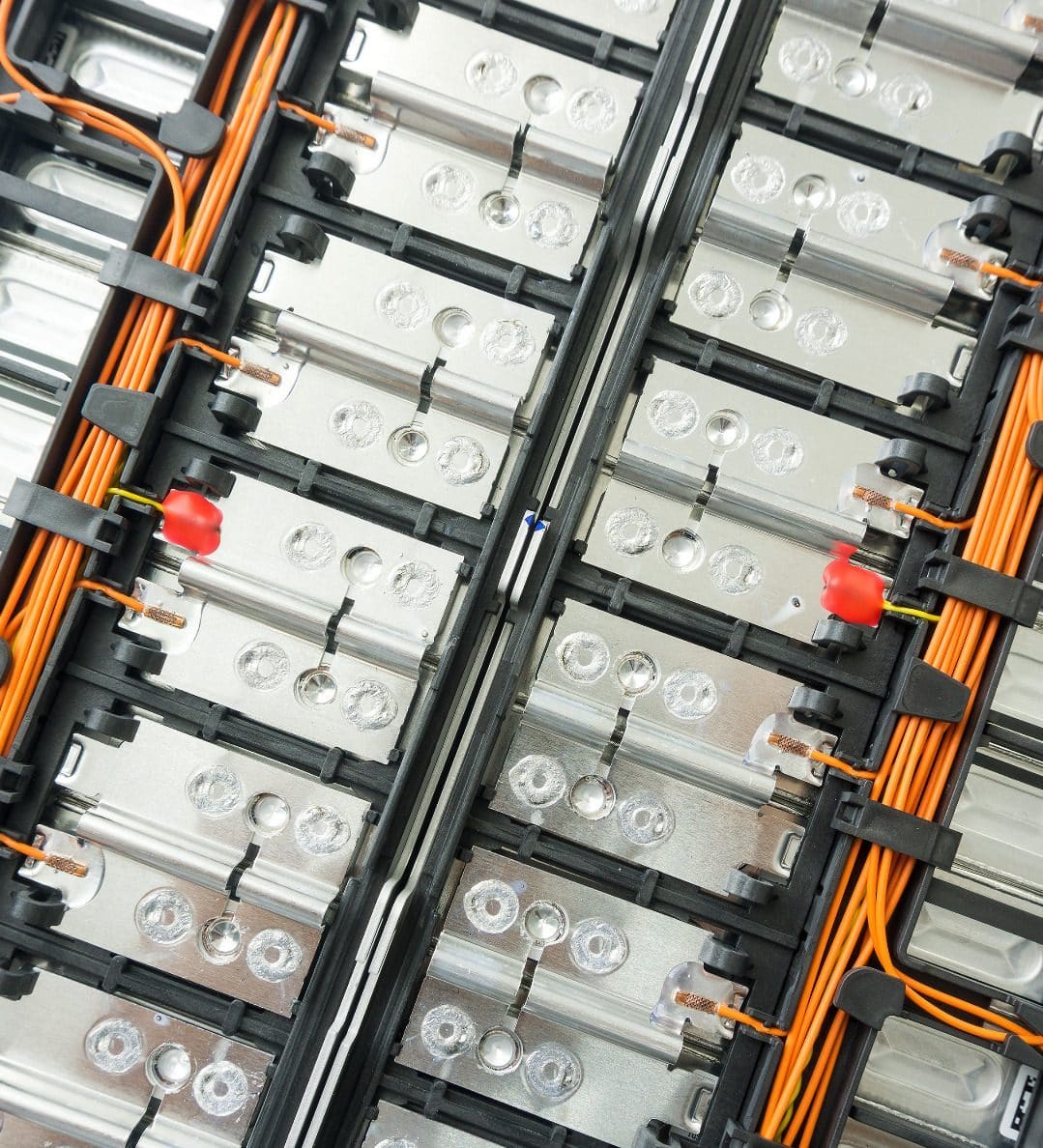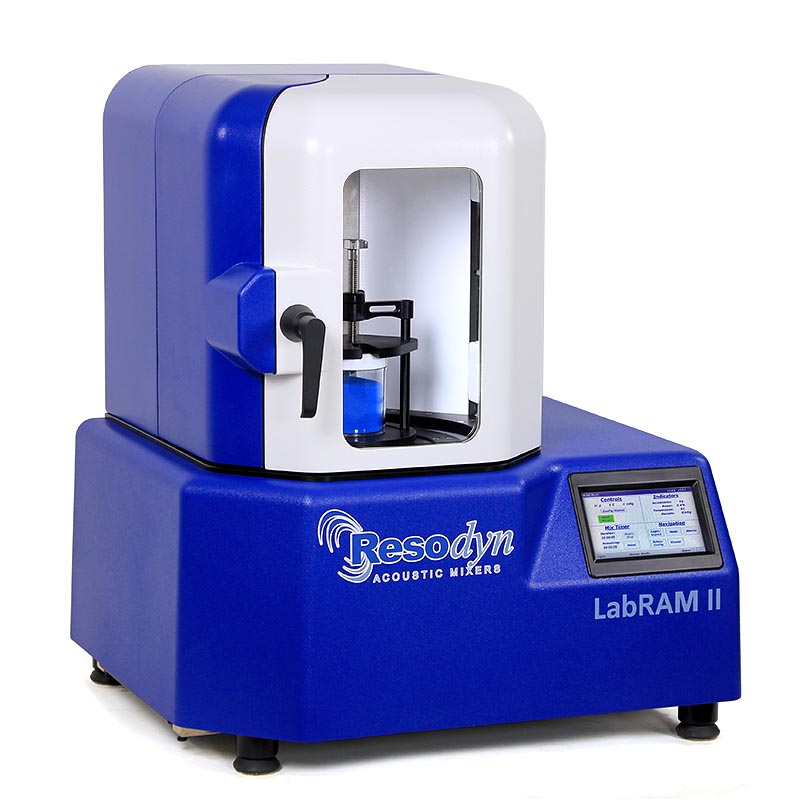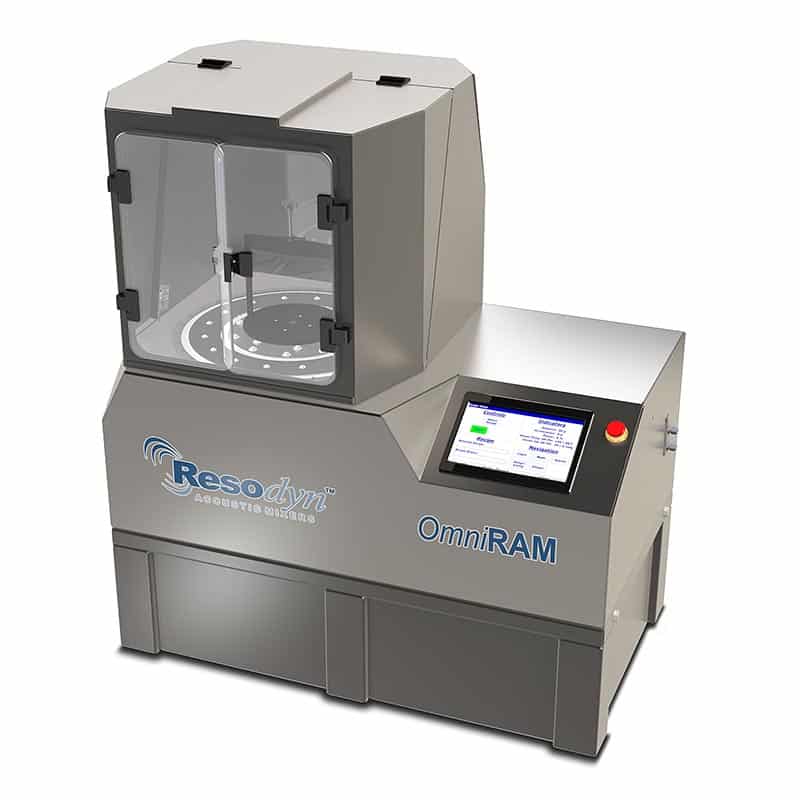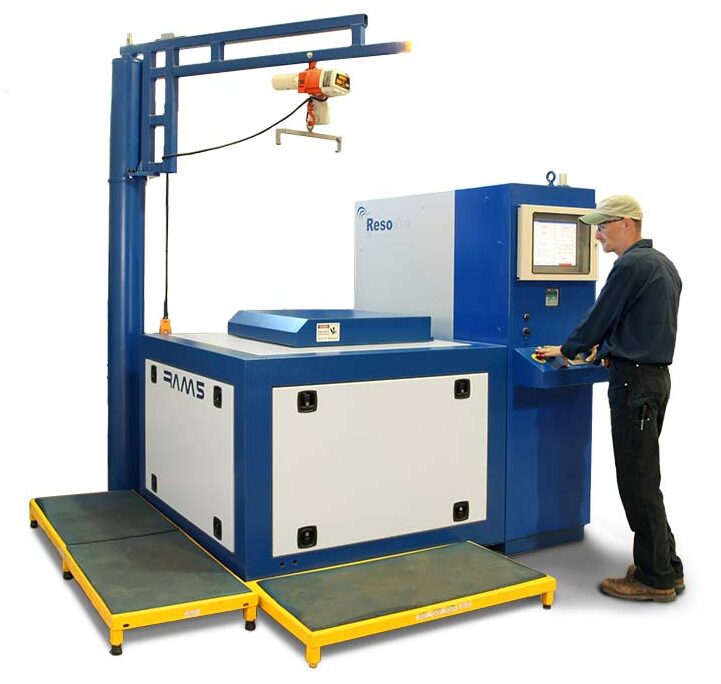

Home » Industries Served » Battery Energy Storage
THE #1 PREFERRED MIXER FOR THE
BATTERY/ENERGY STORAGE INDUSTRY
Resonant acoustic mixing (RAM) is particularly effective for battery manufacturing—especially for mixing electrode slurries (e.g., cathode and anode materials)—because of its unique ability to achieve uniform, high-quality blends without damaging sensitive materials. Here's a breakdown of why it's effective:
🔧 How Resodyn Acoustic Mixing Works
RAM uses low-frequency, high-intensity acoustic energy to induce resonant motion in the mixing container. The entire container vibrates uniformly, transmitting energy into the materials without using blades or impellers. This results in 3D mixing throughout the bulk of the material.
✅ Advantages in Battery Manufacturing
1. Uniform Dispersion of Active Materials
RAM ensures homogeneous mixing of powders and slurries (e.g., NMC, LFP, graphite).
Uniform distribution of active materials and conductive agents (like carbon black) is critical for consistent electrochemical performance.
2. No Shear Damage
Traditional mixing methods (e.g., blade mixers) can degrade sensitive particles or binders (e.g., PVDF).
RAM is gentler and non-destructive, preserving particle integrity and preventing unwanted agglomeration or morphology changes.
3. Improved Electrolyte Wetting and Dispersion
RAM enhances the wetting of particles with binders and solvents, which is crucial for stable slurry formulation and coating quality.
4. No Cleaning Between Batches
Since materials are mixed directly in the final packaging container (e.g., pouches or jars), there's no cross-contamination or need for cleaning between batches—a huge advantage in a cleanroom or high-throughput environment.
5. Scalability and Repeatability
RAM enables lab-to-production scalability with consistent results.
Suitable for small R&D batches up to large-scale manufacturing—important for prototyping and commercialization.
6. Efficient Mixing of High-Solids Slurries
RAM handles high-viscosity, high-solid-content formulations more effectively than traditional mixers, which may stall or become inefficient.
7. Reduced Processing Time
Because of its efficient energy transfer, RAM often achieves faster mixing times, improving throughput and reducing energy consumption.
📦 Common Battery Applications of RAM
- Cathode slurry mixing (e.g., NMC, LFP with binders and solvents)
- Anode slurry mixing (e.g., graphite + binder + solvent)
- Solid-state battery materials
- Electrolyte additives
- Conductive carbon dispersions
The ResonantAcoustic® Mixer (RAM) battery mixing equipment is bladeless and supports a range of battery mixing needs. Materials of different bulk densities, sizes and morphologies are easily mixed. Pastes, gels and powders are accurately batched and evenly dispersed.
RAM systems are fast and effective. Mixing times in battery development have shown reductions from hours down to minutes. Production scale-up is seamless with technical consistency via varying product capacities.
Best in class battery mixing repeatability delivers precision application for:
- Aluminum Oxide-filled Silicone Gels
- Battery Pastes and Slurries
- Copper Pastes
- Densification
- Encapsulation Materials
- Epoxy Insulators
- Ferrite Compounds

INDUSTRY EXPERT
TESTIMONIALS
…we have made our first steps with the new LabRam II from Resodyn Acoustic Mixers. With this second resonant acoustic mixer, we wereable to add another batch size to our large portfolio of different mixing technologies…”
- European battery materials research organization
“We work with multiple battery material mixes, including powder-powder, slurries and pastes. [RAM] gives us a quick, easy and convenient method of mixing, milling and sieving those materials in a single unit.”
- Global energy storage products company
“... the cathode exhibited a higher specific capacity and improved rate performance because of the minimal side reactions at the cathode−solid electrolyte interface. These results demonstrate the success of the Resonant Acoustic® coating of NiCo2S4 NPs on NCM 622.”
- NiCo2S4 Bi-metal Sulfide Coating on LiNi0.6Co0.2Mn0.2O2
Cathode for High-Performance All-Solid-State Lithium Batteries Young-Jin Kim, Rajesh Rajagopal, Sung Kang, and Kwang-Sun Ryu
ACS Omega 2021 6 (10), 6824-6835 DOI: 10.1021/acsomega.0c05942
THE UNIVERSAL BATTERY
MIXING SOLUTION
The ResonantAcoustic® Mixer (RAM) product line harnesses the power of resonance (low-frequency sound) to generate powerful and efficient mixing of complex Solid-Solid, Solid-Liquid, Liquid-Gas, and Liquid-Liquid Blends. RAM systems provide;
- 10-100 X faster mixing times
- bladeless non-contact mixing
- consistent homogenization
- eliminate cleaning
- incredible repeatability
- easy scalability
- long-lasting durability
- custom engineered systems
- erases cross contamination
- huge cost savings
- eco-friendly operation
- unmatched safety
Videos on Battery Mixing
Mix Diverse Battery Material Accurately and Consistently With Breathtaking Speed
ResonantAcoustic® Mixers (RAM) deliver cutting-edge performance for the battery industry, offering unmatched speed and efficiency in mixing advanced materials like solid-state battery components and nanocomposites. These battery mixers ensure precise, consistent results while minimizing solvent use and optimizing production processes.
Loaded Polymer Blending in Less than 3 Minutes!
To illustrate a heavily loaded polymer blend, two materials of very different particle sizes are blended with a polymer surrogate. This footage documents the nature of the material blending and integration into a heavily loaded (~85%) polymer based paste in just over 2 minutes! The use of RAM™ technology is ideally suited for loading of solids into polymers and mixing to a high rate of dispersion and consistent viscosity throughout the blend.
Dissimilar Powder Mixing in 10 Seconds!
Dry ingredients can be difficult to thoroughly and consistently mix, particularly when the particles are of different sizes and characteristics. To illustrate effective and rapid mixing, 10 grams of fumed silica is blended with 100 grams of sand in 10 seconds! Completed specimens exhibit no airborne fumed silica, demonstrating uniform blending at an order of magnitude difference in particle size.
Milling and Nano Coating in 8 Seconds!
Coating larger particles with smaller ones is a common processing application, and milling is often a part of the same process. In this video, agglomerated carbon black particles are simultaneously milled to nano size particles that coat the plastic pellets completely in just a few seconds. The high speed video clearly illustrates the dispersion of carbon black particles, their de-agglomeration, and progressive and comprehensive coating of the plastic pellets.
Articles on Battery Mixing
A Comparative Analysis of Cathode Stripping Methods for Direct Recycling of Spent Li-Ion Batteries
International Manufacturing Science and Engineering Conference
“Our results show that solvent dissolution & resonant acoustic vibration-based cathode stripping achieves an efficiency of up to 92%, without introducing impurities such as small aluminum fragments and powders.”
Xiao, Y., Su, J., & Chen, L. (2023). A Comparative Analysis of Cathode Stripping Methods for Direct Recycling of Spent Li-Ion Batteries. International Manufacturing Science and Engineering Conference. https://doi.org/10.1115/msec2023-105595
From waste graphite fines to revalorized anode material for Li-ion batteries
Carbon
“… mixed by resonant acoustic mixer (RAM, ResoDyn LabRam) at …”
Abrego-Martinez, J. C., Wang, Y., Vanpeene, V., & Roué, L. (2023). From waste graphite fines to revalorized anode material for Li-ion batteries. Carbon, 209, 118004. https://doi.org/10.1016/j.carbon.2023.118004
Functional Surface Coating to Enhance the Stability of LiNi0.6Mn0.2Co0.2O2
Batteries
“The wet powder was then further mixed using Resodyn Acoustic Mixer for 2 min to ensure uniform coverage of the modification solution on the NMC622 surface.”
Xie, Y., Li, M., Li, J., Huang, X., Cai, J., Yang, Z., Nguyen, H., Sulaiman, B. a. S., Karami, N., Chernova, N. A., Upreti, S., Prevel, B., Wang, F., & Chen, Z. (2023). Functional surface coating to enhance the stability of LINI0.6MN0.2CO0.2O2. Batteries, 9(10), 485. https://doi.org/10.3390/batteries9100485
New insight into degradation mechanisms of conductive and thermally resistant polyaniline films
Polymer Degradation and Stability
“...to ensure a homogeneous dispersion, SDP, carbon black, PANI-DNNSA and toluene were acoustically mixed using a Resonant Acoustic Mixer (Resodyn)...”
Yalcin, D., Bamford, S., Espiritu, M., Rigopoulos, N., Martinez-Botella, I., Alexander, D., Gozukara, Y., Greaves, M., Bruton, E. A., Kinlen, P. J., Howard, S., Pigram, P. J., Muir, B. W., & Kohl, T. M. (2023). New insight into degradation mechanisms of conductive and thermally resistant polyaniline films. Polymer Degradation and Stability, 215, 110427. https://doi.org/10.1016/j.polymdegradstab.2023.110427
Stabilization of NCM811 cathode for Li-ion batteries by N-doped carbon coating
Diamond and Related Materials
“In order to obtain uniform carbon coating, Sim et al. [34] developed a resonant acoustic mixing method to prepare carbon-coated NCM811...”
Wang, Z., Zhuang, S., Sun, G., Pan, X., He, J., Sun, Y., Jiang, S., & Ren, Y. (2023). Stabilization of NCM811 cathode for Li-ion batteries by N-doped carbon coating. Diamond and Related Materials, 138, 110233. https://doi.org/10.1016/j.diamond.2023.110233
Resonant acoustic-mixing technology as a novel method for production of negative-temperature coefficient thermistors
Journal of Materials Science Materials in Electronics
“To the best of our knowledge, RAM was applied to produce NTC thermistors for the first time in this study."
Price, B. Y., & Kennedy, S. R. (2022). Resonant acoustic-mixing technology as a novel method for production of negative-temperature coefficient thermistors. Journal of Materials Science Materials in Electronics, 33(14), 11380–11391. https://doi.org/10.1007/s10854-022-08110-2
Material extrusion additive manufacturing of dense pastes consisting of macroscopic particles
MRS Communication
“Two mixing methods have emerged as leaders, dual-axis centrifugal mixing and resonant acoustic mixing..”
Marnot, A., Dobbs, A. & Brettmann, B. Material extrusion additive manufacturing of dense pastes consisting of macroscopic particles. MRS Communications 12, 483–494 (2022). https://doi.org/10.1557/s43579-022-00209-1
Control of carbon dioxide concentration in headspace of multiple flasks using both non-electric bellows pump and shaking incubator
Journal of Bioscience and Bioengineering
“… setting space for wiring or batteries to provide electric power. … the flask gas phase, thus making the gas composition in the … The recently developed resonant acoustic mixing (RAM) for …”
Takahashi, M., & Aoyagi, H. (2022). Control of carbon dioxide concentration in headspace of multiple flasks using both non-electric bellows pump and shaking incubator. Journal of Bioscience and Bioengineering, 134(3), 240–247. https://doi.org/10.1016/j.jbiosc.2022.06.006
Diffusion of Zirconium (IV) Ions from Coated Thick Zirconium Oxide Shell to the Bulk Structure of Ni-Rich NMC811 Cathode Leading to High-Performance 18650 Cylindrical Li-Ion Batteries
Advanced Materials Technologies
“… one of the most important energy storage devices for a wide … on NMC811 by using a resonant
acoustic mixing and sintering at 750 C … Figure 8a shows the images of all 18650 fabrication …”
Tubtimkuna, S., Phattharasupakun, N., Bunyanidhi, P., & Sawangphruk, M. (2022). Diffusion of Zirconium (IV) Ions from Coated Thick Zirconium Oxide Shell to the Bulk Structure of Ni‐Rich NMC811 Cathode Leading to High‐Performance 18650 Cylindrical Li‐Ion Batteries. Advanced Materials Technologies, 7(12). https://doi.org/10.1002/admt.202200436
Novel dry deposition of LiNbO3 or Li2ZrO3 on LiNi0.6Co0.2Mn0.2O2 for high performance all-solid-state lithium batteries
Chemical Engineering Journal
“ResonantAcoustic® Mixing (RAM) technology is preferred embodiment modification of NCM."
Kim, Y., Rajagopal, R., Kang, S., & Ryu, K. (2019). Novel dry deposition of LiNbO3 or Li2ZrO3 on LiNi0.6Co0.2Mn0.2O2 for high performance all-solid-state lithium batteries. Chemical Engineering Journal, 386, 123975. https://doi.org/10.1016/j.cej.2019.123975
Physical Property Analysis of Composite Electrodes with Different Active Material Sizes and Densities using 3D Structural Modeling
Journal of the Korean Electrochemical Society
“...cast anode supports via resonant acoustic mixing technology for solid oxide fuel cells...
Yang, S., Park, J., Byun, S., Kim, N., Ryou, M.-H., & Lee, Y. M. (2020). Physical Property Analysis of Composite Electrodes with Different Active Material Sizes and Densities using 3D Structural Modeling. Journal of the Korean Electrochemical Society, 23(2), 39–46. https://doi.org/10.5229/JKES.2020.23.2.39
Evaluation of RAM [Resonant Acoustic Mixing] Performance
Powder Technology
“Resonant acoustic mixing can significantly reduce blending time, making it a good candidate for improving the efficiency of powder mixing processes.”
Osorio, J. G., & Muzzio, F. J. (2015). Evaluation of resonant acoustic mixing performance. Powder Technology, 278, 46–56. https://doi.org/10.1016/j.powtec.2015.02.033
Use of carbon coating on LiNi0. 8Co0.1Mn0.1O2 cathode material for enhanced performances of lithium-ion batteries
Sci Rep
“...powders were mixed with different amounts (SPB 0.1 wt%, SPB 0.3 wt%, SPB 0.5 wt% and SPB 0.7 wt%) of
super-P carbon black via resonant acoustic mixer (PharmaRAM™ I, Resodyn Acoustic Mixers Inc.) at the acceleration of high mix for 20 min. and then calcined at 300 °C for 3 h.”
Sim, SJ., Lee, SH., Jin, BS. et al. Use of carbon coating on LiNi0.8Co0.1Mn0.1O2 cathode material for enhanced performances of lithium-ion batteries. Sci Rep 10, 11114 (2020). https://doi.org/10.1038/s41598-020-67818-5
Ultra-fast fabrication of tape-cast anode supports for solid oxide fuel cells via resonant acoustic mixing technology
Ceramics International
“[RAM] Slurry optimization in 30 minutes vs. 4,320 minutes using ball mill...”
Park, J. H., Bae, K. T., Kim, K. J., Joh, D. W., Kim, D., Myung, J., & Lee, K. T. (2019). Ultra-fast fabrication of tape-cast anode supports for solid oxide fuel cells via resonant acoustic mixing technology. Ceramics International, 45(9), 12154–12161. https://doi.org/10.1016/j.ceramint.2019.03.119
Polyethylene/Graphene Nanoplatelet Nanocomposite-Based Insulating Materials for Effective Reduction of Space Charge Accumulation in High-Voltage Direct Current Cables
Journal of Nanomaterials
“...LDPE pellets and GNP powders were mixed in a dry state using a resonant acoustic mixer (RAM). GNP particles were uniformly embedded (or coated) on the LDPE pellet surfaces [and] aggregated GNP particles . . . were effectively pulverized by strong collisions between particles in the RAM mixing step...”
Park, Ji Sun, Kim, Young Sun, Jung, Hyun-Jung, Park, Daseul, Yoo, Jee Young, Nam, Jin Ho, Kim, Yoon Jin, Polyethylene/Graphene Nanoplatelet Nanocomposite-Based Insulating Materials for Effective Reduction of Space Charge Accumulation in High-Voltage Direct-Current Cables, Journal of Nanomaterials, 2019, 9035297, 11 pages, 2019. https://doi.org/10.1155/2019/9035297
Synergetic effect of carbon and AlF3 coatings on the lithium titanium oxide anode material for high power lithium-ion batteries
Journal of Electroanalytical Chemistry
“[Lithium Titanium Oxide] with a simultaneous coating layer of carbon and AlF3 formed by acoustic mixing and
post heat treatment shows a potential to further improve commercially-optimized carbon-coated LTO by alleviating its inherently low conductivity. “
Chung, Y., Shin, Y., Liu, Y., Park, J. S., Margez, C. L., & Greszler, T. A. (2019). Synergetic effect of carbon and AlF3 coatings on the lithium titanium oxide anode material for high power lithium-ion batteries. Journal of Electroanalytical Chemistry, 837, 240–245. https://doi.org/10.1016/j.jelechem.2019.02.037
How silicon electrodes can be calendered without altering their mechanical strength and cycle life
Journal of Power Sources
“… remarkable improvement of the cycle life is observed.”
Karkar, Z., Jaouhari, T., Tranchot, A., Mazouzi, D., Guyomard, D., Lestriez, B., & Roué, L. (2017). How silicon electrodes can be calendered without altering their mechanical strength and cycle life. Journal of Power Sources, 371, 136–147. https://doi.org/10.1016/j.jpowsour.2017.10.042
Electrostatic discharge sensitivity and resistivity measurements of Al nanothermites and their fuel and oxidant precursors
Central European Journal of Energetic Materials
“Nanothermite formation mixing was achieved using a lab-scale Resodyn Resonant Acoustic Mixer (LabRAM) with 500 g maximum capacity...lower fill volumes, with resultant reductions in particle-particle interactions, are attractive for the present application.”
Kelly, D., Beland, P., Brousseau, P., & Petre, C. F. (2017). Electrostatic Discharge Sensitivity and Resistivity Measurements of Al Nanothermites and their Fuel and Oxidant Precursors. Central European Journal of Energetic Materials, 14(1), 105–119. https://doi.org/10.22211/cejem/67456
Synthesis of boron-doped Si particles by ball milling and application in Li-ion batteries
Journal of Power Sources
“...It was shown that the use of a resonant acoustic mixer for the mixing of the (Si + carbon black + carboxymethyl cellulose) components increases the cycle life of the composite electrode.”
Rousselot, S., Gauthier, M., Mazouzi, D., Lestriez, B., Guyomard, D., & Roué, L. (2012). Synthesis of boron-doped si particles by ball milling and application in Li-Ion Batteries. Journal of Power Sources, 202, 262–268. https://doi.org/10.1016/j.jpowsour.2011.11.045
Vanadium oxide nanowire–carbon nanotube binder-free flexible electrodes for supercapacitors
Advanced Energy Materials
“...a low frequency resonant acoustic mixing technique made for … improvements in battery applications and
nanowires in the composite paper...”
Perera, S. D., Patel, B., Nijem, N., Roodenko, K., Seitz, O., Ferraris, J. P., Chabal, Y. J., & Balkus, K. J. (2011). Vanadium oxide nanowire–carbon nanotube binder‐free flexible electrodes for supercapacitors. Advanced Energy Materials, 1(5), 936–945. https://doi.org/10.1002/aenm.201100221
ResonantAcoustic® Mixing for Lithium-ion Battery Manufacture
Resodyn Acoustic Mixers
“Investigation of RAM for blending materials used in Li-ion battery electrodes. Mixing process took less than one minute compared to six hours by traditional mixers.
Admin. (2025, January 18). RAM mixing for lithium-ion battery manufacturing. Resodyn Acoustic Mixers. https://resodynmixers.com/2010/06/28/ram-mixing-for-lithium-ion-battery-manufacturing/
Relevant Patents for Battery Mixing and Development
Approved and pending applications for work involving the use of ResonantAcoustic® mixing technology.
Solvent-free process for preparing lithium-ion batteries
WO FR FR31333709A1 French, Ohla, et al, Cabot Corp
Filed 2023-03-20 • Published 09-22-2023
A solvent-free process employs a multifunctional carbon black to prepare compositions and electrodes for lithium-ion batteries. The multifunctional carbon black provides two or more desirable characteristics, acting, for example, as a conductive carbon additive, as a fibrillation agent and/or as a mechanical reinforcement. In one example, an electroactive material, for example, graphite or a lithium transition metal compound, a binder and a multifunctional carbon black are combined in one or more steps. High shear mixing is used to process the binder in the presence of the multifunctional carbon black. The resulting composition can be formed into a film which can be applied to a suitable substrate to produce an electrode.
Compositions and methods for parallel processing of electrode film mixtures
US WO US20230216057A Ziying Wang, et al, Maxwell Technologies
Priority 2023-03-19 • Filed 2023-03-19 • Published 2023-07-06
Materials and methods for preparing electrode film mixtures and electrode films including reduced damage bulk active materials are provided. In a first aspect, a method for preparing an electrode film mixture for an energy storage device is provided, comprising providing an initial binder mixture comprising a first binder and a first active material, processing the initial binder mixture under high shear to form a secondary binder mixture, and nondestructively mixing the secondary binder mixture with a second portion of active materials to form an electrode film mixture.
Cathode active material for secondary battery
WO WO2023080629A1 Daijin Lee, LG Energy Solutions, Inc.
Priority 2022-11-01 • Filed 2022-11-02 • Published 2023-05-11
The present invention relates to a cathode active material for a secondary battery, wherein the cathode active material has a structure in which a shell composed of niobium oxide partially containing an alkaline earth metal is adsorbed onto the surface of a core containing lithium metal oxide, whereby the contact void phenomenon that may be generated between the cathode active material and the solid electrolyte and side reactions therebetween are reduced and the electrode resistance increase according to charging/discharging is suppressed. Thus, the secondary battery including same has the advantage of increasing life span.
High molecular weight functionalized polymers for electrochemical cells
WO WO20230494A1 Alexander Ali Ibrahim Mohamed, Andrew Paul Leitner, Ionic Materials, Inc.
Filed 2022-09-27 • Published 2023-03-30
High molecular weight functionalized polymers (“high dielectric polymers”) are disclosed herein, along with related methods of use and manufacture. The high dielectric polymers have a relatively high dielectric permittivity (e.g., greater than 10) as well as a relatively low glass transition temperature (e.g., less than -30˚C). The polymers may be produced utilizing addition polymerization or anionic ring opening to yield a linear or branched polymer backbone containing numerous residual nucleophiles. Then, nucleophilic substitution may be carried out to functionalize the residual nucleophiles. The functionalized polymer may then be purified and used as polymer electrolyte in an electrochemical cell (e.g., as nonaqueous polymeric electrolyte in a secondary Li-ion battery), if desired.
KR EP JP US CN TW JP221349B2 Kim, Jung Ho
Filed 2021-09-14 • Published 2022-01-11
The present invention relates to a catalyst, a method for preparing the same, an electrode, a membrane-electrode assembly and a fuel cell containing the same, and in particular, to form a coating layer on the surface of a commercial catalyst or an existing catalyst in a relatively gentle manner without separate treatment. The durability is further improved by post-treating the catalyst containing the coating layer to form a carbon coating layer, and the carbon nanofibers or carbon nanotubes generated during the post-treatment process further improve the durability. The present invention relates to a catalyst having improved mass transfer ability and performance, a method for producing the same, an electrode, a membrane-electrode assembly and a fuel cell including the same.
US US20230343936A1 Tae Gon Kim, et al, LG Energy Solution Ltd.
Filed 2021-08-31 • Published 2023-10-26
Provided is a positive electrode active material including a core and a coating layer disposed on the core, wherein the core includes Li1+xMyO2+z, wherein M is at least one element selected from the group consisting of nickel (Ni), cobalt (Co), manganese (Mn), iron (Fe), phosphorus (P), aluminum (Al), magnesium (Mg), calcium (Ca), zirconium (Zr), zinc (Zn), titanium (Ti), ruthenium (Ru), niobium (Nb), tungsten (W), boron (B), silicon (Si), sodium (Na), potassium (K), molybdenum (Mo), and vanadium (V), wherein −0.2≤x≤0.2, 0<y≤2, and 0≤z≤2, wherein the coating layer includes carbon-based particles, wherein the carbon-based particles includes a structure in which a plurality of graphene sheets are connected to each other, and wherein a D/G peak ratio of the positive electrode active material is in a range of 0.9 to 1.3 during Raman spectrum measurement.
JP WO EP CN KR WO202050664A1 Tae Gon Kim, et al, LG Energy Solution, Ltd.
Priority 2021-08-31 • Filed 2021-08-31 • Published 2022-03-10
The present invention relates to a positive electrode active material, a positive electrode comprising the positive electrode active material, and a secondary battery comprising the positive electrode, the positive electrode active material comprising: a core; and a coating layer disposed on the core. The core comprises Li1+xMyO2+z, M being at least any one element selected from the group consisting of Ni, Co, Mn, Fe, P, Al, Mg, Ca, Zr, Zn, Ti, Ru, Nb, W, B, Si, Na, K, Mo and V, and -0.2≤x≤0.2, 0<y≤2, 0≤z≤2. The coating layer comprises carbon-based particles, wherein the carbon-based particles comprise a structure having a plurality of graphene sheets connected to each other, and have a D/G peak ratio of
0.9 to 1.3 when measuring the Raman spectrum thereof.
Compositions and methods for electro-chemical cell component fabrication
EP US WO US20230076834A1 Binson Li, et al, Navitas Systems LLC
Priority 2021-03-01 • Filed 2021-03-01 Published • 2023-03-09
Provided are methods of producing materials suitable for use as a component of an electrochemical cell such as electrode active layers or solid state electrolyte and/or separator materials. Processes include combining an active with a fibrillizable binder and intermixing in a screw fibrillator to produce a fibrillized material with greatly increased physical and optionally electrochemically characteristics relative to those materials produced by other processes such as simple slurry casting or intermixing in a jet mill.
Method of manufacturing electrode, electrode manufactured by the same, membrane …
WO EP US CN JP JP2020145210A Kim, Jung Ho, et al, Kolon Industries
Priority 2016-12-28 • Filed 2020-06-08 • Published 2020-09-10
To provide an electrode with improved various performances by increasing a utilization rate of a catalyst and an ionomer and a carbon structure having improved dispersion stability of the carbon structure and the ionomer. SOLUTION: Provided are an electrode, including a catalyst 2 and an ionomer 3, …
Method for manufacturing ionomer coated carbon structure and ionomer coated …
KR KR102175008B1 Ryoichi Namba, Toyota Jidosha Kabushiki Kaisha
Priority 2017-01-02 • Filed 2017-01-02 • Granted 2020-11-05 • Published 2020-11-05
The present invention relates to a method of manufacturing a carbon structure coated with an ionomer, a carbon structure coated with an ionomer, a carbon structure coated with the ionomer, a carbon structure assembly coated with an ionomer, and the film-ionomer A fuel cell comprising a coated …
Hydrophobic coatings comprising hybrid microspheres with nano/micro roughness
WO EP CN KR TW TW202003718A Guang Pan, et al, Nitto Denko Corporation
Priority 2018-05-31 • Filed 2019-05-31 • Published 2020-01-16
Described herein are coatings based on a hydrophobic polymer matrix and hydrophobic nanoparticles that provide a damage tolerant hydrophobic, superhydrophobic, and/or snowphobic capability, wherein the nanoparticles can comprise modified and phyllosilicate nanoclays. The micro and nano roughness …
Graphene-carbon hybrid foam-protected anode active material coating for lithium …
WO WO2020154258A1 Bor Z. Jang, Global Graphene Group, Inc.
Priority 2019-01-21 • Filed 2020-01-21 • Published 2020-07-30
Provided is a porous anode material structure for a lithium-ion battery (and method of manufacturing same), the structure comprising (A) an integral 3D graphene-carbon hybrid foam comprising multiple pores, having a pore volume Vp, and pore walls; and (B) coating of an anode active material, …
Method of producing graphene-carbon hybrid foam-protected anode active material …
US US20200235393A1 Bor Z. Jang, Nanotek Instruments, Inc.
Priority 2019-01-21 • Filed 2019-01-21 • Published 2020-07-23
Provided is method of producing a porous anode material structure for a lithium-ion battery, the method comprising (A) providing an integral 3D graphene-carbon hybrid foam comprising multiple pores, having a pore volume Vp, and pore walls; and (B) impregnating or infiltrating the pores with a …
Molten electrolyte dual-phase membranes for intermediate temperature fuel cells
WO US US20190379063A1 Patrick Campbell, et al, Lawrence Livermore National Security LLC
Priority 2019-06-07 • Filed 2019-06-07 • Published 2019-12-12
In one aspect of an inventive concept, a fuel cell system includes a cathode and an anode, a porous ceramic support positioned between the cathode and anode, and a molten electrolyte mixture in pores of the ceramic support. In another aspect of an inventive concept, a method for producing energy includes directing a gas stream through a cathode,
where an inner side of the cathode is adjacent to a dual phase membrane including a ceramic support infiltrated with a molten electrolyte mixture, sweeping an outer side of the anode with water …
WO US CN JP KR JP2019521476A Aruna Zhamu & Bor Z. Jang, Nanotek Instruments, Inc.
Priority 2016-06-07 • Filed 2017-06-01 • Published 2019-07-25
The anode includes an integrated 3D graphene-carbon hybrid foam composed of a plurality of pores, pore walls, and a lithium adsorbing metal present in the pores, the metals being Au, Ag, Mg, Zn, Ti, Na , K, Al, Fe, Mn, Co, Ni, Sn, V, Cr, or alloys thereof, in an amount of 0.1% to 50% of the total …
Supercapacitor having an integral 3D graphene-carbon hybrid foam-based electrode
WO US CN JP KR US9905373B2 Aruna Zhamu, Bor Z. Jang, Nanotek Instruments, In.
Priority 2016-01-04 • Filed 2016-01-04 • Published 2018-02-27
Provided is a supercapacitor having an anode, a cathode, a porous separator/electrolyte, wherein at least one of electrodes contains an integral 3D graphene-carbon hybrid foam composed of multiple pores and pore walls, wherein the pore walls contain single-layer or few-layer graphene sheets …
Integral 3D graphene-carbon hybrid foam separation device
US US10058842B1 Aruna Zhamu, Bor Z. Jang, Global Graphene Group, Inc.
Priority 2015-12-28 • Filed 2018-06-01 • Published 2018-08-28
Provided is an integral 3D graphene-carbon hybrid foam composed of multiple pores and pore walls, wherein the pore walls contain single-layer or few-layer graphene sheets chemically bonded by a carbon material having a carbon material-to-graphene weight ratio from 1/100 to 1/2, wherein the few- …”
Method for producing polymer matrix composite
WO EP US CN JP KR TW JP2021503525A Derek Dane Jay, et al, 3M Innovative Properties Co.
Priority 2017-11-16 • Filed 2018-11-15 • Published 2021-02-12
A method for producing a polymer matrix composite containing a porous polymer network structure and a plurality of particles dispersed in the polymer network structure, wherein the thermoplastic polymer, a solvent in which the thermoplastic polymer is soluble, and a plurality of particles are used …
EP US CN JP KR TW KR20190078489A Jung Ho Kim
Priority 2017-12-26 • Filed 2018-11-28 • Published 2019-07-04
The present invention relates to a catalyst, a producing method thereof, and an electrode, a membrane-electrode assembly, and a fuel cell including the same. The catalyst comprises: a carrier; metal particles supported on the carrier; and a coating layer positioned on the metal particles and …
Method for manufacturing electrode, electrode manufactured by using the same, …
KR KR102189064B1 Jung Ho Kim, Hyung-soo Kim
Priority 2016-12-28 • Filed 2016-12-28 • Published 2020-12-09
The present invention relates to a method of manufacturing an electrode, an electrode manufactured thereby, a membrane-electrode assembly including the electrode, and a fuel cell including the membrane-electrode assembly, wherein the method of manufacturing the electrode comprises mixing a …
Chemical-free production of 3D graphene-carbon hybrid foam
US US9597657B1 Aruna Zhamu, Nanotek Instruments, Inc.
Priority 2015-12-28 • Filed 2015-12-28 • Published 2017-03-21
Provided is a method of producing an integral 3D graphene-carbon hybrid foam, comprising: (a) mixing multiple particles of a graphitic material and multiple particles of a solid polymer carrier material to form a mixture in an impacting chamber of an energy impacting apparatus; (b) operating the …
Synthesis of soluble conducting polymers by acoustic mixing
US US9441075B1 Marie C. Kane, Sandia Corporation
Priority 2014-04-09 • Filed 2014-04-09 • Published 2016-09-13
A method including combining an aniline monomer, an oxidant, water and an organic solvent; subjecting the combination to acoustic mixing to form an emulsion; and recovering a polyaniliine from the combination. A method including combining a aniline monomer, an oxidant, water and an organic solvent …
Folio
White Papers
BATTERY DEVELOPMENT
PRODUCTS
LabRAM II
1,000 gram capacity for recipe development
Up to 2.2 lb (1,000 gram) payload capacity full-featured, digitally controlled batch mixer for bench-scale development, mixing, and processing.
OmniRAM
5 kg capacity for pilot-scale production
Up to 2.2 lb (1,000 gram) payload capacity full-featured, digitally controlled batch mixer for bench-scale development, mixing, and processing.
RAM 5
36 kg capacity for pilot and production scale
80 lb (36 kg) payload capacity, digitally controlled, batch mixer with multiple processing capabilities and options for pilot production and processing.








